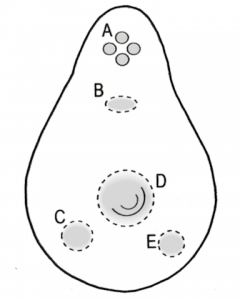This is a review of the Health Edco breast models. Designed for teaching self breast examination, we’ve used these models for teaching M3 students, as part of their training in breast disease.
Pros: Durable, No Maintenance, Has different lumps of different sizes in different locations.
Cons: Breast material too stiff, Not very realistic for teaching exams
Overall Grade: 2.0/5.0
Three different sized breasts come in a solid case. Also included is a small bottle of talc, and a drawing indicating the location of each of the four lumps. In addition to the four palpable lumps, there is a cluster of lesions at the top of the breast that are not palpable. These are to illustrate that not all abnormalities can be felt and strengthens the argument for mammography.

Originally designed for teaching self breast exams, these models are also widely used to train healthcare providers. I’ve used them as part of a breast exam teaching module in the Simulation Lab, for M3s. There are several nice features of these models.
- They are very durable, particularly when enclosed in their fabric cover.
- They are conveniently packaged, so storage is simple.
- Each breast has multiple masses of varying size, and varying location.
I particularly like the subareolar mass. Because of physical and psychological sensitivities, the subareolar area is frequently examined in a cursory manner. That’s unfortunate because many ductal cancers arise in that area, due to the high concentration of ducts. This model reinforces the need for thorough examination, including the subareolar area.
But there are some drawbacks to these models as well. The biggest problem I’ve found is that the breast tissue of the manikin is too stiff and unyielding. In order to palpate these lumps, you really have to dig in deeply with two fingers. This makes them difficult to examine.

I have some difficulty finding the lumps, and I know where they’re located. Someone not provided that information will miss many if not most of the lumps. Because the technique needed to find these lumps is different than the technique used in real patients, using these models will reinforce the wrong technique.
“Gentle but firm palpation” won’t work with these models. You need “forceful and deep palpation” to find these lumps.
It’s easier to find the lumps in the smaller breasts, but still requires a technique that is applicable only to the model, and not real people.
One annoying thing about the models is that they are coated in an oily substance that sticks to your hands, and any desktop you place them on. We always use a pad underneath them to soak up this material.
Overall, I give this model a 2 out of 5. While it demonstrates breast lumps, it forces the students to use a technique they can’t use in real patients. I think it’s better than nothing, but only somewhat better.
